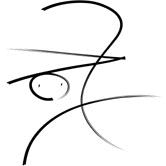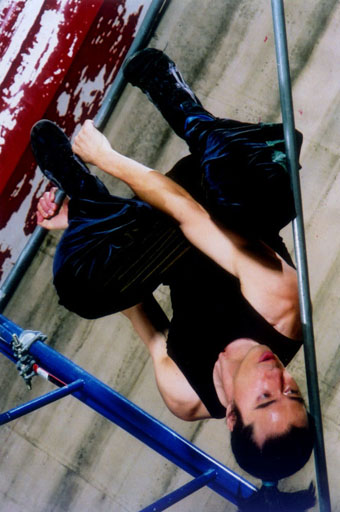
|
|||||
|
|
Dancing
Off the Floor with Wire Monkey by Jessica deCourcy Hinds |
||||
|
When I saw Wire Monkey's debut performance at the Northampton Center for the Arts, I kept forgetting to breath. After all, I was watching dancers who could fly. With a lightning speed, the seven dancers climbed, swung and soared across the bars of a sophisticated jungle gym: 20 fret of scaffolding that suggested an urban rain forest. Watching the dancers, I often had to remind myself they were adults (this is a compliment!) for they rollicked and played with such a childlike glee. And yet, at times they just as convincingly embodied wise, soulful, and serene characters. When the dancers cradled and supported each other high up on the steel bars, they movingly explored territories of vulnerability, love, and primal human connections. The idea for Wire Monkey came to Saliq Francis Savage one night a dream. Savage, who has a rich background in choreography and structured improvisational dance, has performed and taught all over the world. After his dream vision of people swinging through the trees, Savage quickly bought scaffolding, set it up in the garden, and began dancing on it. Jennifer Polins (co-director) collaborated with Savage in the garden from the earliest stages of the project. Polins' choreographic experience began in Zurich, Switzerland, and she has impressive credits in modern, ballet and improvisational companies. When I spoke with Polins and Savage, it was clear that they are an exciting creative team, each fueling the other's ideas and visions. I can see how the dancers in their group would be inspired by their penetrating questions about humanity, and buoyed by their sparkling enthusiasm and sense of wonder. Just being around them for an hour made me feel more creative! When I visited them in South Hadley, we sat by a big window and watched the Connecticut river snake by. It was interesting to watch two people, who dance together, talk together. Even when they came at ideas from different angles, they did so gracefully, their insights flowing together as smoothly as the river. Jessica deCourcy Hinds: How did you impose structure on this dance and still allow for spontaneity? Saliq Savage: You begin, Jen. I'll chime in. Jennifer Polins: A lot of what you saw was set work, but the source of this was improvisation, based on states, themes and ideas that we wanted to explore. There were rules--a structure. We tried to hold to so it wasn't completely free improvisation. JdeCH: What would be an example? SS: For instance, one of the sections of the dance is called Level Aggression. The image for Level Aggression comes from the economic stratification in our world, the rich and the poor, privileged and underprivileged. So the dancers were given a task. Those above were to push down those below, to take them to the ground. This evolved into the vying for power, for the creation of distrust in the group. Within that conceptual structure the dancers improvised. Of course there was movement technique taught to accompany the conceptual that has to do with forming relationships along spirals. JP: There is a place within the dance where Level Aggression always occurs that has a specific beginning and a specific ending. Within the section itself the dancers also have certain landmarks or set relationships with the structure and with each other that came out of the creative process. JdeCH: When you're first conceiving themes like Level Aggression how do you communicate with the other dancers and make sure everyone understands, and is working with the same vision? SS: I'm not sure that the dancers do really understand. (laughs) Of course we all understand as we do. And so there is a realm in which we are exploring and often I will describe that realm in many different words. Sometimes this is confusing for the dancers who want specific instructions. Underlying Level Aggression is an understanding of the Spiral, which is a felt experience. Most things in life are connected through spirals. DNA spirals. Bone structure if you break it down to a microscopic level is organized in rings, (rotates his arms in the air) One spirals in one direction and the next ring spirals in the other direction and on and on JP: And muscles. SS: The fibers [in muscles], the actin and myosin and the way they connect all spirals. So, this is a basic state of being. It's subtle [...] and that's where my training in Body-Mind Centering plays a role. That's where I trained myself to understand these physical states. I brought this out (a toy with wooden beads and wooden bars connected with elastic) This demonstrates Tensegrity. It's the relationship between the solid pieces and elastic forces. (Savage presses down on the toy and it flexes. When he lifts his hand, the elastic toy springs back up again. He does this several times carefully compressing the toy so that the elastic compresses without collapsing). This toy combines two types of structures, the stable/solid and the flexible/fluid. In the dynamic relationship between these two types of structures there are the potential for power and explosive force. It is also the antidote to level aggression with its inherent imbalance of power. So this is a big concept for me. It represents the place of meeting where the tissues can meet in a balanced cooperative state. JP: Your attraction to dance came partly from communicating with others in this primal place SS: I want a three-year-old to be able to comprehend what's going on in Wire Monkey. At once it's primal, but it's also very sophisticated, the sense of Tensegrity. It is the spiral that connects two people powerfully yet with choice and freedom. (Saliq and Jen hold onto each other's arms, just behind the elbows, and both lean backwards) If we make a spiral that connects us like this, we have a very powerful connection. At this point, either one of us could disengage and unravel the connection. We're [only] holding on to each other by the spiral there is no grasping or clenching. All either one of us has to do is release the spiral and weĠre out. But as long as we both engage in the spiral-we can support huge force. JdeCH: Could you talk about the interaction between dance and culture in Wire Monkey. When I read your material, you very clearly state that the dancers in Wire Monkey are from Africa, Europe and North America. You are both from this country, but you've lived abroad. How has the cultural richness of Wire Monkey impacted the collaboration-and do you think dance is a language? JP: Dance is universal, it's a language. I remember going to Paris when I was little and being able to take a ballet class even though I could not speak French because I could understand the movements. Improvisation doesn't have such a tightly prescribed vocabulary-but still, contact improvisation and improvisational dance creates a vocabulary. There is a huge international community that shares this language SS: Well, I'll say something about the Group. Somehow, in this process [of collaboration] myself and the dancers really became a tribe. The relationships between the dancers were very important to the overall message that was conveyed. And that the group comes from diverse ethnic backgrounds was a factor in how we were able to come together. And another thing-there's a state of being that joins the dancers throughout the piece. The dancers were not asked to be soldiers carrying out my vision. Rather they were asked to make their own meaning and so they came forward with their individuality, desires, hopes and fears. One of the universal themes presented is about the developmental journey from unity and wholeness to isolation and individuation and back to bonding within the tribe. At one point in the dance we show the beginning with being in the womb, a state of incubation. There's a duet between Jen and I, below the scaffolding, and the scaffolding is rotating around us and we're encasing one another into a small womb space. We go into this [small] space that represents basic human comfort-or discomfort. Images of nurturing and confinement overlap. And that's one of the things I wanted to show in the piece-When are your needs just not being met? How can we understand love when basic needs are not being met? And then something about the need to communicate from there, and the creation of symbols and then eventually language. JdeCH: There's a moment in the dance when the dancers seem afraid and frantic, and you're all banging on the scaffolding. It was incredibly loud. There was an image in my mind of rainforest or environmental destruction. What was the source of the violence and fear for you? SS: There's not a simple answer. That's part of the reason we made a dance about it. I think we should be afraid right now. The world is not safe. I wanted to explore violence, and the place where there's violation-because I think we're violating the planet right now, in an unrecoverable way. The resources of the planet are being used up. That's why it's not a rainforest we're dancing in. We're dancing in steel. It's an urban jungle JP: For me, the [scaffolding] represented restriction and danger. And everything that we face in our lives that is not safe. We have to decide and choose around danger all the time. There's this magic in finding playfulness and freedom and joy within the structure that is metal and unforgiving-if you're not looking out you bang your shin! So, this combination of freedom and play within restriction and danger is very juicy. There is a certain amount of danger that makes you feel more alive. I think that's one reason why people respond [to Wire Monkey] so strongly. There's this danger and fear involved with the audience watching the dancers. Rather than just dancing on the floor the dance becomes spectacular. JdeCH: When you spun the scaffolding around, it glowed with light-and it seemed so warm it didn't feel like a cage. SS: A home. JdeCH: Yes, it seemed like a home and a cage! What about that wonderful moment when you spun the scaffolding around and looked out into the audience? SS: In the rotation, this was a reversal. The dancers are mirroring the public, and we're looking at you-and you're looking at us. So there's a mirroring. How can you make sense of your cage, and the constraints you're putting on yourself? Who's in the cage anyway? Saliq and Jennifer can be contacted at saliq@mediaone.net |
|||||

